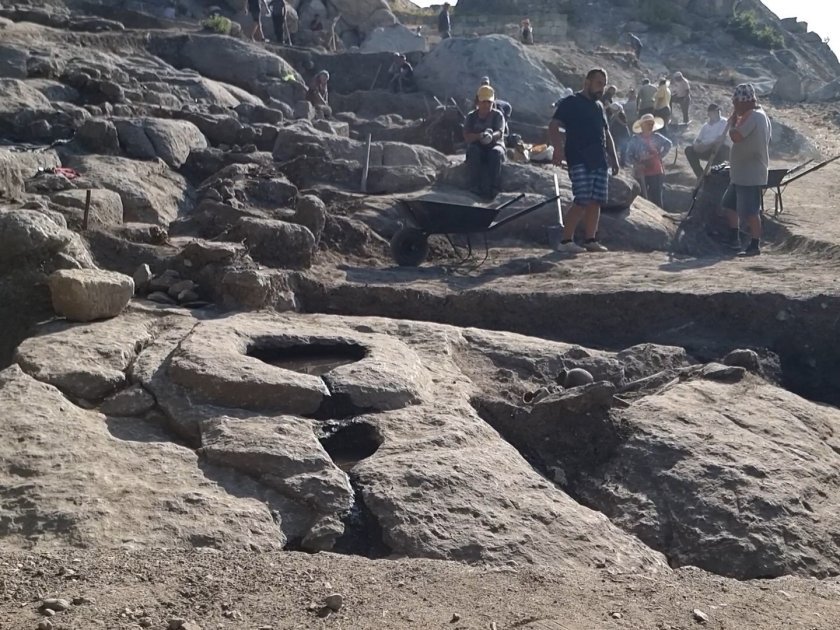Two pagan altars uncovered at Perperikon archaeological site
One of the altars was for making sacred wine and the other for animal sacrifices

The latest discoveries at Perperikon - two altars, one of them for blood sacrifices, outline an area "sacra" in the southern quarter of the archaeological site. This was announced by the head of the excavations team, prof. Nikolay Ovcharov on September 4.
Today he made a demonstration of one of the altars, which he said was for blood sacrifices, public, in the open.
"Since the altar we are currently uncovering is from the Roman era, we are also using data about that era and making a comparative reconstruction. It is a small basin that collects about 5 to 7 litres of liquid. At the end of the basin there is a hole through which the liquid flows out into a few channels, from where it goes to a second basin from which the liquid also drains," explained Prof. Ovcharov.
According to the archaeologist, this was probably an altar for the underground gods. At that time, people were not dressed in white, but in black, the animals had black fur. During the execution, the head was bent down to let the blood flow into a special pool.

He added that relatively small animals were sacrificed - goats, sheep that were prepared the previous day. It was imperative that the animals were healthy, and that the animal itself went willingly, rather than being dragged.
According to prof. Ovcharov said that the altar in question is related to the 3rd-4th century temples that have been studied in the Southern Quarter in recent years and outline the so-called area "sacra".
"It includes the temple of the Thracian Horseman, the temple of Mithras, the Temple of the Ancestors, the unidentified temple, probably of wine, which we discovered two years ago, the mausoleums, which are temples of a kind. We expect there will be more finds, the first being the two great altars for sacrifices. One was visible before the excavation, but we now have its chronology," Prof Ovcharov explained.

Images by BTA
According to the archaeologist, the altar was most likely a real sacred wine sharappan, made as early as the end of the Bronze Age and the beginning of the Iron Age or 3,500 years ago. It was used throughout the pagan period and abandoned in the Middle Ages.
The excavations at the archaeological site Perperikon continues, with about 60 people working on it. This year they have been in the field for four months and are expected to continue work until early November. The allocated funds amount to half a million BGN, and at the beginning of the excavations prof. Nikolay Ovcharov announced that they were the largest in the 25-year period of research at Perperikon.
Source:BTA
Latest archaeological discovery at the ancient Thracian city of Perperikon
***
The ancient Thracian city of Perperikon is located in the Eastern Rhodope mountains, Southerm Bulgaria, 15 km northeast of the present-day town of Kardzhali, on a 470 m high rocky hill, which is thought to have been a sacred place.
The village of Gorna krepost ("Upper Fortress") is located at the foot of the hill and the gold-bearing Perpereshka River flows nearby.
Perperikon is the largest megalith ensemble site in the Balkans.
As an archaeological site, Perperikon is an 8,000-year-old prehistoric megalithic shrine, which was later built upon by the Thracians, the Romans, the Byzantines, and the medieval Bulgarian Empire.
Exhibition dedicated to Bulgarian ancient city of Perperikon was opened in the European Parliament
New archaeological finds at the ancient site of Perperikon
Archaeologists Found “City of the Dead” at Perperikon
Get the latest news wherever you are!
Follow us on
Facebook
and
Instagram
Follow BNT’s YouTube channel
You can now also watch us on
TikTok
Find us on
Google News






















